Birds in the News #12
This week, my peeps and I found lots of interesting and entertaining links about birds for you. Of course, I begin my report with birds in science, and one of these articles describes how Caspian terns, Sterna caspia, reveal humanity's hubris, then I move on to conservation news with an update on efforts to protect a newly-described and incredibly rare manakin species, and then I provide a large update on the World Series of Birding. I also have links to online audio interviews with Tim Gallagher, author of The Grail Bird (and don't forget that I also have an upcoming interview with Tim Gallagher on my blog next week). I end this week's Birds in the News with the reader photoblog of the week featuring an adult male pileated woodpecker. This digital image is astonishingly clear and shows the field marks for this species extremely well. You will never mistake pileated and ivory-billed woodpeckers for each other agan after seeing this image!
As always, if you have an interesting link or photograph, feel free to email them to me (email is linked on the left-hand sidebar; I am not writing it here because my email box is being spammed mercilessly right now).
Birds in Science:
Bird brains are much more complex and human-like than previously thought, and thus, birds offer insights into human brains and behavior. Birds show us that many things thought to be unique to humans just ... aren't. The authors of the research papers cited in this article wrote, "when you show that [a] pigeon can recognize itself in a mirror, or that a crow can manufacture a tool, it is not just an interesting demonstration, but it also refines our views regarding the neural mechanism that underlie such behavior."
New high-tech DNA research has shown that the extinct heath hen was a unique species, instead of being a subspecies of the greater prairie chicken, Tympamuchus cupido, as widely thought. The heath hen was native to much of the eastern seaboard from Maine to North Carolina. It was persecuted by overhunting and habitat destruction until only a remnant population remained on Martha's Vineyard. They became extinct in 1932, when the last individual of the species, a male, disappeared and was later declared dead. [Original paper: Palkovacs, E.P., A.J. Oppenheimer, E. Gladyshev, J.E. Toepfer, G. Amato, T. Chase & A. Caccone. 2004. Genetic evaluation of a proposed introduction: the case of the greater prairie chicken and the extinct heath hen. Molecular Ecology 13:1759-1769.]
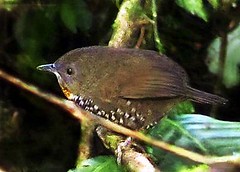 Unseen by humans for 58 years, and known only from a single female collected in 1947, rusty-throated wren-babbler, Spelaeornis badeigularis (pictured), is even more mysterious than the ivory-billed woodpecker. In this story, two ornithologists report that they recently rediscovered this species in India's Arunachal Pradesh region.
Unseen by humans for 58 years, and known only from a single female collected in 1947, rusty-throated wren-babbler, Spelaeornis badeigularis (pictured), is even more mysterious than the ivory-billed woodpecker. In this story, two ornithologists report that they recently rediscovered this species in India's Arunachal Pradesh region. The active volcano, Mount St. Helens in southwestern Washington state, has been a source of much research ever since its dramatic eruption on 18 May 1980 that killed 57 people and destroyed thousands of acres of pristine habitat. These two news updates find that there are a large variety of avian species and amphibian species that have recolonized in the blast zone during the past 25 years.
Beginning 20 years ago, when the U.S. Army Corps of Engineers dredged the Columbia River to make way for bigger ships, they created sandy islands that attracted "thousands of squabbling Caspian terns [who] pack the sand like giant cotton balls — fluttering on the breeze, strutting like little emperors or screeching at one another like an army of monkeys". Charming as these birds are, they also are devouring endangered salmon species, pushing the salmon ever closer to the brink of extinction. This story reveals some of the complexities involved when people mess around with the environment. (Isn't that description of the birds simply grand?)
Bird Conservation:
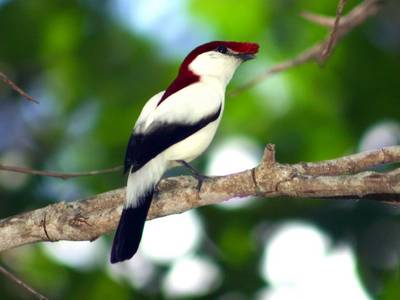
Photograph courtesy of Araripe Manakin Project
Researching rare birds in the field is often difficult and challenging work. With fewer than 250 individuals alive today, the recently discovered Araripe manakin, Antilophia bokermanni (a male is pictured above), is an extremely rare bird species. This story describes the efforts of the BP Conservation Program’s Conservation of the Araripe Manakin Project to protect this boldly patterned species in the Chapada do Araripe region of Brazil while documenting its breeding cycle.
The United States government involved in neotropical conservation, too. Interior Secretary Gale Norton last Saturday marked the 12th annual International Migratory Bird Day by announcing $3.9 million in federal grants to conserve birds throughout the Americas and the Caribbean.
This lengthy and important article is not about birds specifically, but I linked to it because it describes a recent report documenting that protecting the planet's biodiversity also protects people.
World Series of Birding:
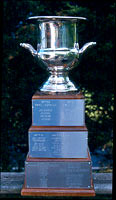 At the conclusion of the World Series of Birding (WSB), it was reported that Cornell Univerity's ornithology lab team, the Sapsuckers, established a new fund-raising record for avian conservation. Bird lovers pledged $700 for every bird species the five-member team could find in New Jersey during the 24-hour competition for a total of $147,000 donated. "It's a big game, basically," said team member Kevin McGowan. "And it's also a fund-raiser." Pledged money will go towards avian conservation. The Delaware Valley Ornithological Club took home the 2005 Urner Stone Cup (pictured) for seeing and hearing the most bird species this year (222). The Sapsuckers captured fourth place overall and second place for nonresident teams, with 211 species.
At the conclusion of the World Series of Birding (WSB), it was reported that Cornell Univerity's ornithology lab team, the Sapsuckers, established a new fund-raising record for avian conservation. Bird lovers pledged $700 for every bird species the five-member team could find in New Jersey during the 24-hour competition for a total of $147,000 donated. "It's a big game, basically," said team member Kevin McGowan. "And it's also a fund-raiser." Pledged money will go towards avian conservation. The Delaware Valley Ornithological Club took home the 2005 Urner Stone Cup (pictured) for seeing and hearing the most bird species this year (222). The Sapsuckers captured fourth place overall and second place for nonresident teams, with 211 species. The Boreal Songbird Initiative's team, the Boreal Birders, who I have been following here for the past several weeks, finished in seventh place overall with 197 species seen or heard -- an impressive finish for a first-year team! If you visit the Boreal birder's blog, you can learn how many Boreal bird species the team found during the WSB.
A total of 262 species of birds were seen by all teams combined during the competition. Click here for PDFs of the WSB final standings, the winners and youth teams information.
Ivory-billed Woodpecker News and Mania:
The Big Woods Birding Festival takes place in Clarendon, Arkansas, this Saturday, 21 May. Because this town is very close to where the ivory-billed woodpecker was rediscovered, this year's main attraction will feature a series of presentations about the search for and rediscovery of this woodpecker in the Big Woods of Arkansas. The presentations will begin at 11:00 am in the courtroom of the historic Monroe County Courthouse. Phil Hoose, author of The Race to Save the Lord God Bird, will discuss the history of the ivory-bill and sign his book. Ivory-bill search team members Martjan Lammertink of the Cornell Lab of Ornithology and David Luneau of the University of Arkansas at Little Rock will discuss the evidence leading to the publication of the rediscovery in the journal Science. At 1:00 pm, Gene Sparling will tell his story about the first confirmed sighting of the ivory-billed woodpecker in 60 years. At this time, Lammertink will also give a short presentation about the biology of the bird and methods used in the search. Scott Simon from The Arkansas Nature Conservancy will speak about TNC's role in the search. Members of the search team will be available throughout the day to speak with the public. (Click here for more information about the festival). Are there any bloggers who will attend and write summaries of these presentations for all of us? (Gee, I wish I was there so I could do this!)
The artist, Larry Chandler, who painted the ivory-billed woodpecker's portrait solely from a verbal description from one of the search party members is also reaping financial rewards as reported in artist to benefit from woodpecker sighting. "It's a great shot in the arm for my career with the notoriety I'm getting," Chandler said. His painting, Elusive Ivory, is so accurate that the Cornell Laboratory of Ornithology uses it on their website.
Laura Erickson's audio interview of Tim Gallagher, author of The Grail Bird and ivory-billed woodpecker search party member, are online at BirderBlog. The interview is broken into six mp3 files, all of which are linked from BirderBlog. Includes lots of recorded sound files of ivory-billed woodpecker calls and raps on trees.
Incidentally, when you visit Clarendon's Big Woods Birding Festival, you might enjoy a new and very fashionable haircut.
Birds Hurting People:
In revengeful acts of Hitchcockian savagery, several large black grackles defended their offspring by attacking people who came too close to them. The parent birds' aggressiveness caused the Houston, Texas police to close down pedestrian access to a sidewalk near their nest. Interestingly, the birds were particularly aggressive towards a lawyer, who was treated for his injuries.
Birds Helping People
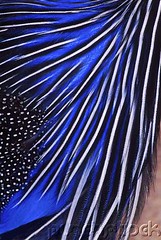 Farmers and other people who live in rural areas in the United States have been increasingly attracted to keeping Guinea fowl, the numididae. These birds, natives of Africa and the island of Madagascar, present a natural way to control invertebrate parasites, particularly ticks, which transmit Lyme disease to warm-blooded animals, including humans. Pictured is a close-up of a vulturine Guinea fowl, Acryllium vulturinum.
Farmers and other people who live in rural areas in the United States have been increasingly attracted to keeping Guinea fowl, the numididae. These birds, natives of Africa and the island of Madagascar, present a natural way to control invertebrate parasites, particularly ticks, which transmit Lyme disease to warm-blooded animals, including humans. Pictured is a close-up of a vulturine Guinea fowl, Acryllium vulturinum.People Helping Birds:
The state of Arkansas is home for the ivory-billed woodpecker as well as several other species, including the very rare red-cockaded woodpecker, Picoides borealis. A pair of these birds, which have color patterns similar to those of its larger and more famous cousin, recently produced four chicks, exciting ornithologists. "Gold, man; this is gold right here in my hand," Bill Holimon said while holding a chick, estimated to be 7 days old. "It’s the prettiest thing I’ve seen in quite a while." Holimon is an ornithologist and grants coordinator for the Arkansas Natural Heritage Commission.
For much of the 20th century, the property that is now Hilton Pond Center for Piedmont Natural History in York, South Carolina, was open farmland. Now that this land is re-forested, the bird life is changing dramatically, and there is evidence that white-breasted nuthatches, Sitta carolinensis, are breeding on site. For a photo essay about this interesting little cavity nester, please visit this installment of "This Week at Hilton Pond". This linked page includes wonderful close-up pictures of a white-breasted nuthatch (scroll down).
The Oklahoma Biological Survey is developing a bird information page based on WIKI software. For those familiar with Wikipedia, this is the same open access format. This format allows anyone with web access to add, delete or edit each page. These pages are primarily devoted to birds in Oklahoma. The Oklahoma Biological Survey is also seeking contributions from the public in the form of text, photos, or song recordings.
Audio/Video Birds:
The May edition of On The Wing, the audio magazine of birds and birding, is available now - it's bird festival season, with trips to Edmonds and Leavenworth (Washington state)! Also featured are the Magnuson Park Cliff Swallows, the re-discovery of the Ivory-Billed Woodpecker, the Accidental Birder, the Raptor Nest Data Project, and the Events Calendar. You can download the audio segments to your computer or mp3 player.
Tarantulas, snakes, and cowbirds? No, it is not the stuff of a bad birding movie, but during this past week, these are the creatures that have visited the Nest Box Cams, linked by Cornell's Laboratory of Ornithology. To summarize this week's activities; first, a brown-headed cowbird, Molothrus ater, removed a prothonotary warbler egg, Protonotaria citrea, from its nest and the next day replaced it with its own egg in the cavity. But this morning, the cowbird egg is no longer in the nest. Then, in Texas, a surprise visit from a large snake (thought to be an Eastern Rat Snake) resulted in the snake constricting one of the barn owlets to death while the other five owlets watched. Actually, one of the owlets appeared to be trying to fight the snake off with its talons. But at this point, observers don't know if the snake managed to actually eat the young or if it just killed it and then left the scene for fear of being eaten itself. They do know that one of the chicks was lying dead on the floor, and was then consumed by its siblings. That same day, an image was captured of a large tarantula in the vacant Texas bluebird box. To end on a happy note, four of six Eastern Bluebirds, Sialia sialis, have hatched!
Reader Photoblog of the Week:
In view of all the excitement over woodpeckers, I found this picture of the second largest North American woodpecker to share with you (the largest, of course, is the ivory-billed woodpecker).
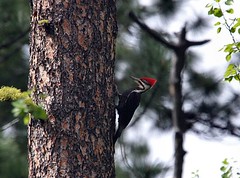 This photograph of a male pileated woodpecker, Dryocopus pileatus, was taken by birder and amateur photographer, Mac Knight, who writes; this picture was taken in the middle fork area of the Ahtanum Creek, west of Yakima, Washington state. The bird pictured is one of a nesting pair in the area. My wife and I went up there to find the woodpeckers after being told they were in the area by another Yakima Audubon member. We were specifically looking for pileated woodpeckers and Williamson's sapsuckers, since we had no pictures of either bird.
This photograph of a male pileated woodpecker, Dryocopus pileatus, was taken by birder and amateur photographer, Mac Knight, who writes; this picture was taken in the middle fork area of the Ahtanum Creek, west of Yakima, Washington state. The bird pictured is one of a nesting pair in the area. My wife and I went up there to find the woodpeckers after being told they were in the area by another Yakima Audubon member. We were specifically looking for pileated woodpeckers and Williamson's sapsuckers, since we had no pictures of either bird.We found a pileated nesting west of Yakima and got a few shots of the bird as it returned to the nest. We also found many other woodpeckers in this excellent site, including Williamson's sapsuckers, white-headed woodpeckers, hairy and downy woodpeckers, and several others we were unable to see clearly enough to identify.
I used a Canon 10d digital camera with a Canon 100/400mm lens and a 1.4x multiplier on a tripod to take the picture. I used to shoot 35 mm but converted to digital when Canon came out with a reasonably priced camera that accepted my lenses. I've been an amateur photographer for 30 years and have been concentrating on birds for the last two years since joining the Audubon Society.
You also must look at this picture of the same male "kissing" his mate at their nest tree (male on right, peeking out of nest, female is on left, in full view).
Previous : : Birds in the News : : Next
Academic Job Interviews: 2 (for Adjunct Assistant Professorships -- "Adjunct" is a fancy way of saying "part-time temporary" employee)
Job Offers: 5 (all Adjunct positions, but one position has real promise)
Academic Job Rejections: 2 (Lecturer of Evolutionary Science, Assistant Professor of Molecular Genetics)
© 2004, 2005, 2006 by GrrlScientist











3 Peer Reviews:
A feast of bird stories. That was quite a tale of the week's happenings on bird cams. Have you ever checked out Rurality (rurality.blogspot.com)? She's got a couple of shots of a rat snake eating a duck egg. Quite spectacular.
That is a beautiful shot of the pileated woodpecker. Just so wonderful that people are out there with their cameras.
I had read about the grackles protecting their nests in that very Hitchcockian fashion in Texas. Quite an interesting display of behaviors.
Much thanks for the bird posts - a great prelude to my decidedly unproductive day of watching woodpeckers, blue jays, and a Cooper's hawk (who keeps getting harassed by a couple of little birds that I can't identify - how odd)!
After seeing those wonderful pictures, I'm tempted to spend my fall tuition money on a nice camera. Doh!
I do find it difficult to find scholarly info on parrots, though. Most of the literature I find is pet-oriented, and I don't need a book to tell me how cute and animated they are, since I live with an overbonded blue and gold! So I'll conclude with a self-serving request for some (academic) parrot blogging!
Jamie
Thanks for reading, RD and Jamie. I did peek at Rurality's blog and the snake pictures were interesting .. I've never seen a snake allow a person to get so close, even if they are wearing a camera.
I will be writing more about parrots .. soon, Jamie. I am finishing my first parrot paper right now and am not willing to say much about it until after it is in review .. something about hostile competitors who wish to scoop me ..
GrrlScientist
Post a Comment
<< Home